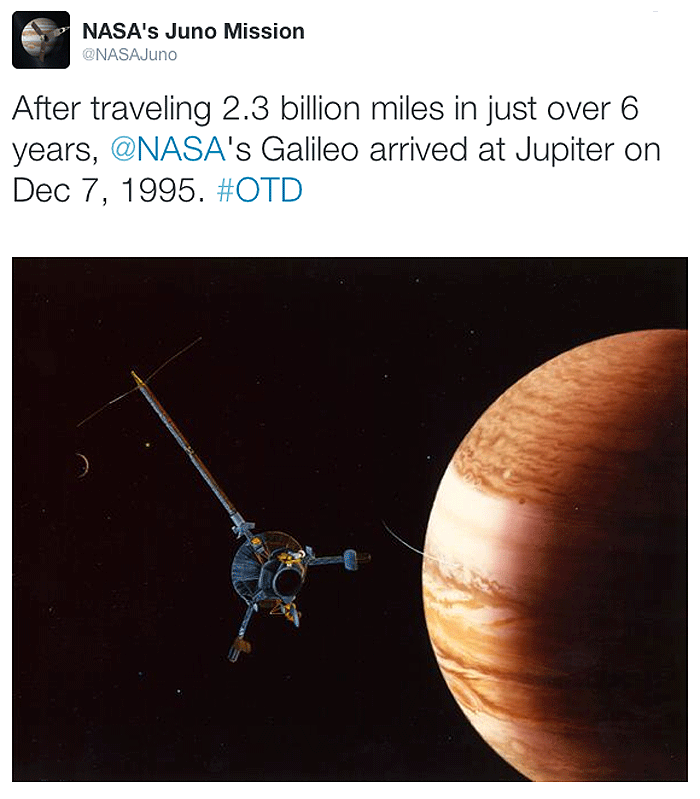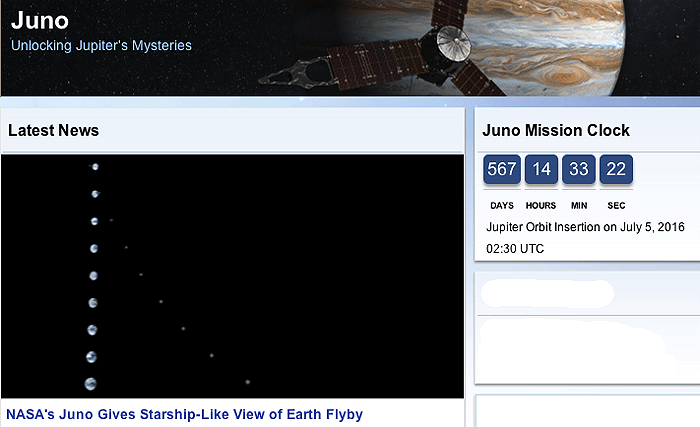.
5.01.2013
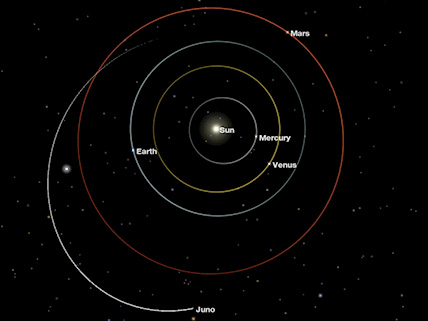
View of Juno’s position on Jan. 4 from Eyes on the Solar System.
-
As of Jan. 4, Juno was approximately 180 million miles (290 million kilometers) from Earth, with a one-way radio signal travel time of approximately 16 minutes. The spacecraft has now traveled 583 million miles (938 million kilometers, or 6.27 AU) since launch. Juno is currently traveling at a velocity of 11 miles (17 kilometers) per second relative to the sun. Velocity relative to Earth is 21 miles (34 kilometers) per second.
The Juno spacecraft is in excellent health and is operating nominally. Four instruments -- JEDI, MWR, Waves, and MAG -- are turned on.
Most recent spacecraft significant events
Juno is currently headed back toward the inner solar system for a planned Earth flyby gravity assist maneuver on Oct. 9, 2013. The gravity assist will give the spacecraft the boost it needs to reach Jupiter, where it is slated to arrive in July 2016.
-
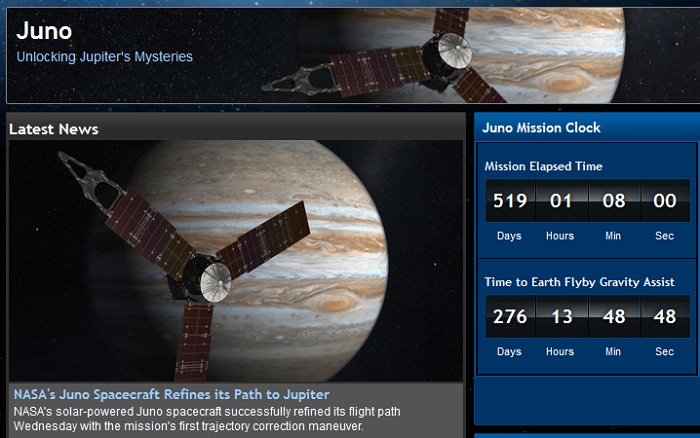
-
NASA's Juno Spacecraft Images Big Dipper

NASA’s Jupiter-bound Juno spacecraft tested its JunoCam instrument on one of the icons of the night sky – the Big Dipper. Image credit: NASA/JPL-Caltech/SWRI/MSSS
-
In England it is known as the "Plough," in Germany the "Great Cart," and in Malaysia the "Seven Ploughs." Since humanity first turned its eyes skyward, the seven northern hemisphere stars that compose the "Big Dipper" have been a welcome and familiar introduction to the heavens.
"I can recall as a kid making an imaginary line from the two stars that make up the right side of the Big Dipper's bowl and extending it upward to find the North Star," said Scott Bolton, principal investigator of NASA's Juno mission to Jupiter from the Southwest Research Institute in San Antonio. "Now, the Big Dipper is helping me make sure the camera aboard Juno is ready to do its job."
Launched on Aug. 5, 2011, the solar-powered Juno spacecraft is 279 days and 380 million miles (612 million kilometers) into its five-year, 1,905-million-mile (3,065-million-kilometer) journey to Jupiter. Once there, the spacecraft will orbit the planet's poles 33 times and use its nine instruments to image and probe beneath the gas giant's obscuring cloud cover to learn more about Jupiter's origins, structure, atmosphere and magnetosphere, and look for a potential solid planetary core.
One of those instruments, JunoCam, is tasked with taking closeups of the gas giant's atmosphere. But, with four-and-a-half years to go before photons of light from Jupiter first fill its CCD (charge-coupled device), and a desire to certify the camera in flight, Juno's mission planners took a page from their childhood and on March 21, aimed their camera at a familiar celestial landmark.
"I don't know if it’s the first space-based image of the Big Dipper but, as it was taken when we were well beyond Mars orbit, it's probably from the farthest out," said Bolton. "But much more important than that is the simple fact that JunoCam, like the rest of this mission, works as advertised and is ready for its day in the sun – around Jupiter."
Juno's name comes from Greek and Roman mythology. The god Jupiter drew a veil of clouds around himself to hide his mischief, and his wife, the goddess Juno, was able to peer through the clouds and reveal Jupiter's true nature.
NASA's Jet Propulsion Laboratory, Pasadena, Calif., manages the Juno mission for the principal investigator, Scott Bolton, of Southwest Research Institute in San Antonio. The Juno mission is part of the New Frontiers Program managed at NASA's Marshall Space Flight Center in Huntsville, Ala. JunoCam was developed and is operated by Malin Space Science Systems in San Diego. Lockheed Martin Space Systems, Denver, built the spacecraft. JPL is a division of the California Institute of Technology in Pasadena.
Quelle: NASA
.
Update: 21.02.2013
.
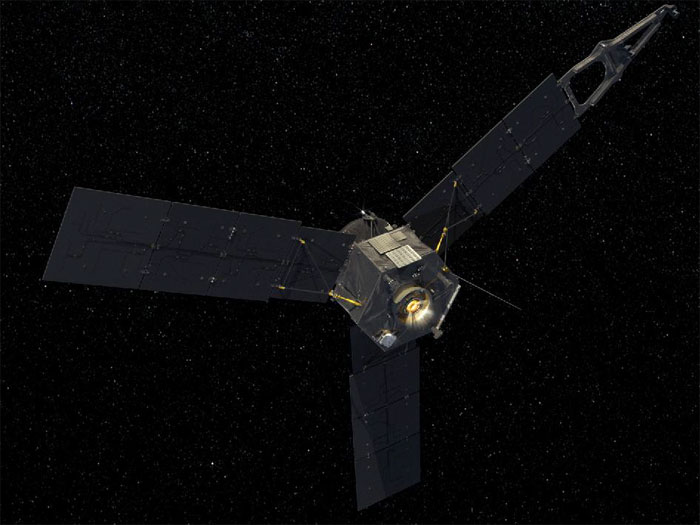
.
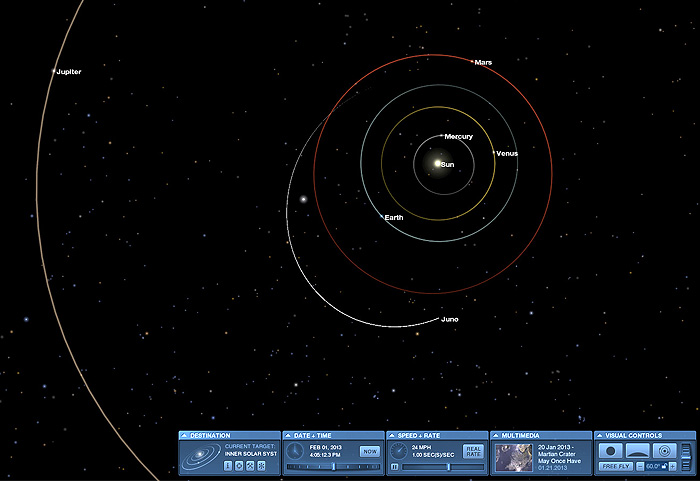
.

Quelle: NASA
.
Update: 5.05-2013
PASADENA -- On its way to Jupiter, NASA's Juno spacecraft will fly past a surprising place later this year: Earth.
NASA launched the satellite in 2011 to a region of space just past Mars, but it's boomeranging back to this planet to get a gravity assist for its final journey to Jupiter. When it flies past on Oct. 9, the Earth's gravity will boost Juno like a slingshot, a technique that helps save fuel and money.
"A year ago ... we did two main engine burns" to curve back around toward Earth, said former mission manager Steve Matousek of Jet Propulsion Laboratory, speaking at Caltech last week. "Then after that, it takes less than three years to get to Jupiter. On the other end, you have to slow down. "
Once it gets there in 2016, Juno will begin a polar orbit around Jupiter for about a year, circling 32 times. Scientists hope the spacecraft can answer questions about the gas giant's cloudy interior and possibly reveal the planet's role in the formation of the solar system.
Juno is carrying instruments that will help it peer underneath the gaseous surface of hydrogen and helium that keeps Jupiter's interior shrouded in mystery and will be able to detect if there's a rocky core and water deep within the planet.
"There has to be water vapor there - it's been seen experimentally from the Earth - but where is it and how much is it?" Matousek said. "Juno is designed to see globally how much
water vapor there is. "
The mission will only last a year because Jupiter's gravity affects the spacecraft's orbit, increasing the amount of radiation that hits Juno's equipment. It's the same problem that affected NASA's previous mission to Jupiter, Galileo, which arrived in 1995.
Engineers also kept Jupiter's moons in mind when designing the mission, particularly the one scientists are most interested in exploring, Europa.
"In the future we want to send a mission to Europa," Matousek said. "There's a very small probability that if Juno went uncontrolled ... over time you get a probability that you're going to encounter Europa,"
To prevent that, the mission will end with Juno making a controlled descent into Jupiter and burning up in the atmosphere.
But there will be plenty of chances to get excited about seeing Juno fly by this year (though it might not be seen from the U.S.), and when it arrives at Jupiter around July 4, 2016.
"Fireworks will be going off over the Rose Bowl," Matousek said.
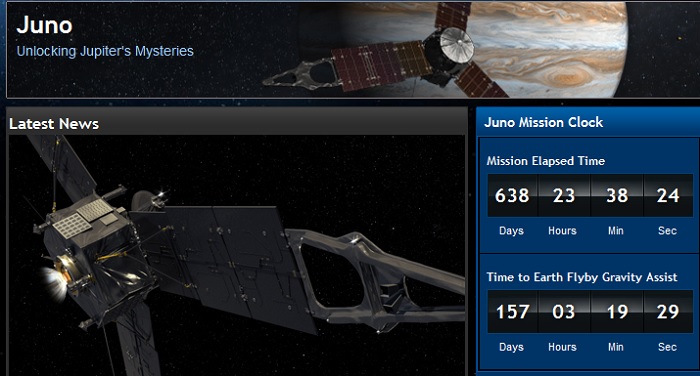
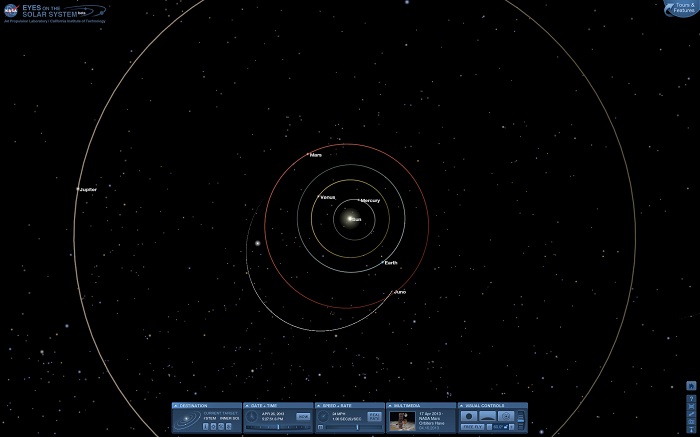

,
Update: 12.08.2013
.
NASA's Juno is Halfway to Jupiter
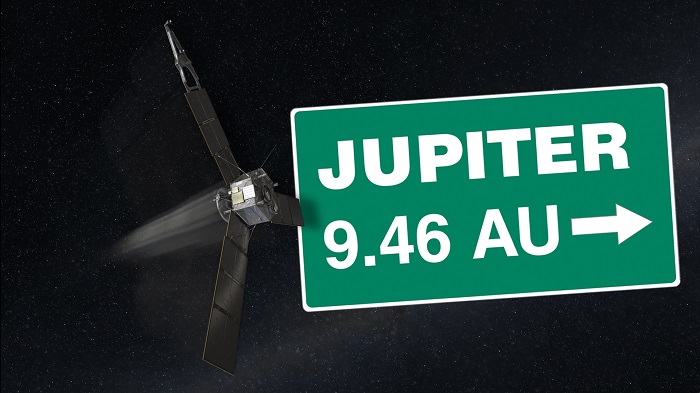
PASADENA, Calif. - NASA's Juno spacecraft is halfway to Jupiter. The Jovian-system-bound spacecraft reached the milestone today (8/12/13) at 5:25 a.m. PDT (8:25 a.m. EDT/12:25 UTC).
"Juno's odometer just clicked over to 9.464 astronomical units," said Juno Principal Investigator Scott Bolton, of the Southwest Research Institute in San Antonio. "The team is looking forward, preparing for the day we enter orbit around the most massive planet in our solar system."
For those astronomical-unitly challenged, an astronomical unit (AU) is a unit of measure used by space engineers and scientists when discussing the massive distances involved in the exploration of our solar system – and beyond. An AU is based on the distance between Earth and the sun and is 92,955,807.273 miles (149,597,870.7 kilometers) long. The 9.464 astronomical units Juno has already traveled (or still has left to go) is equivalent to 879,733,760 miles (or 1,415,794,248 kilometers). Juno was 34.46 million miles (55.46 million kilometers) from Earth when the milestone was reached.
The next milestone in the nearly five-year journey to Jupiter will occur this October, when the spacecraft flies past Earth in search of a little extra speed.
"On Oct. 9, Juno will come within 347 miles (559 kilometers) of Earth," said the mission's Project Manager Rick Nybakken of NASA's Jet Propulsion Laboratory in Pasadena, Calif. "The Earth flyby will give Juno a kick in the pants, boosting its velocity by 16,330 mph (about 7.3 kilometers per second). From there, it's next stop Jupiter."
Juno will arrive at Jupiter on July 4, 2016, at 7:29 p.m. PDT (10:29 p.m. EDT).
Juno was launched on Aug. 5, 2011. Once in orbit around Jupiter, the spacecraft will circle the planet 33 times, from pole to pole, and use its collection of eight science instruments to probe beneath the gas giant's obscuring cloud cover. Juno's science team will learn about Jupiter's origins, structure, atmosphere and magnetosphere, and look for a potential solid planetary core.
Juno's name comes from Greek and Roman mythology. The god Jupiter drew a veil of clouds around himself to hide his mischief, and his wife, the goddess Juno, was able to peer through the clouds and reveal Jupiter's true nature.
NASA's Jet Propulsion Laboratory, Pasadena, Calif., manages the Juno mission for the principal investigator, Scott Bolton, of Southwest Research Institute in San Antonio. The Juno mission is part of the New Frontiers Program managed at NASA's Marshall Space Flight Center in Huntsville, Ala. Lockheed Martin Space Systems, Denver, built the spacecraft. JPL is a division of the California Institute of Technology in Pasadena.
Quelle: NASA
.
Update: 4.10.2013
.
JUNO SPACECRAFT TO FLY BY EARTH: Here's some news you might not hear from NASA because, like much of the US government, the space agency is closed. NASA's Juno spacecraft will slingshot past Earth on October 9th for a velocity boost en route to Jupiter. At closest approach the spacecraft will be only 347 miles from Earth as it gains an extra 16,000 mph for the long journey ahead. Update: During the flyby, Juno's science instruments will sample the Earth environment--a practice run for data-taking at Jupiter years from now. Fortunately, commands to activate Juno's sensors were uploaded before the shutdown. The science experiment can proceed. Radio amateurs are encouraged to beam a message to Juno during the flyby. Juno will be listening.
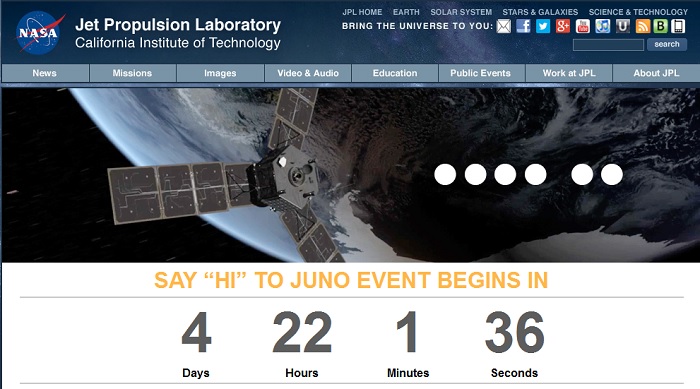
.
Update: 9.10.2013
.

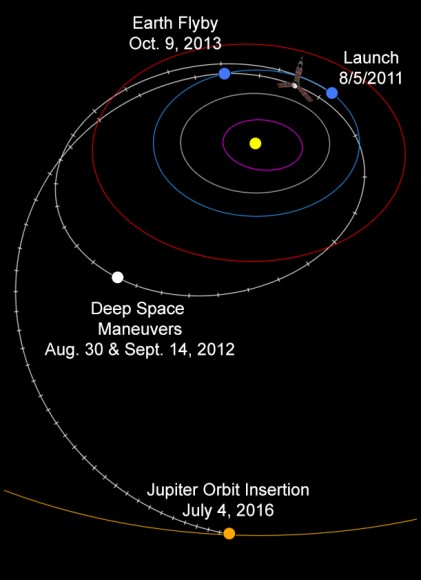
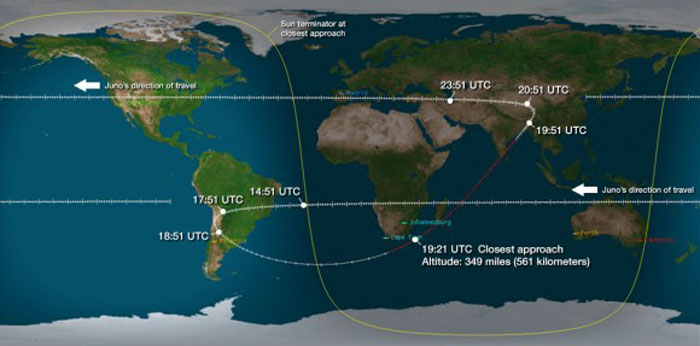


Update: 10.10.2013
.
JUNO SPACECRAFT PHOTOGRAPHED:
.
Yesterday, NASA's Juno spacecraft buzzed Earth only 347 miles above our planet's surface. It was a slingshot maneuver designed to gain velocity for Juno's long trip to Jupiter (ETA: 2016). Although the spacecraft was very faint, several amateur astronomers managed to photograph. The spacecraft is now hurtling away from Earth at 23,500 mph. Bon voyage, Juno!
.
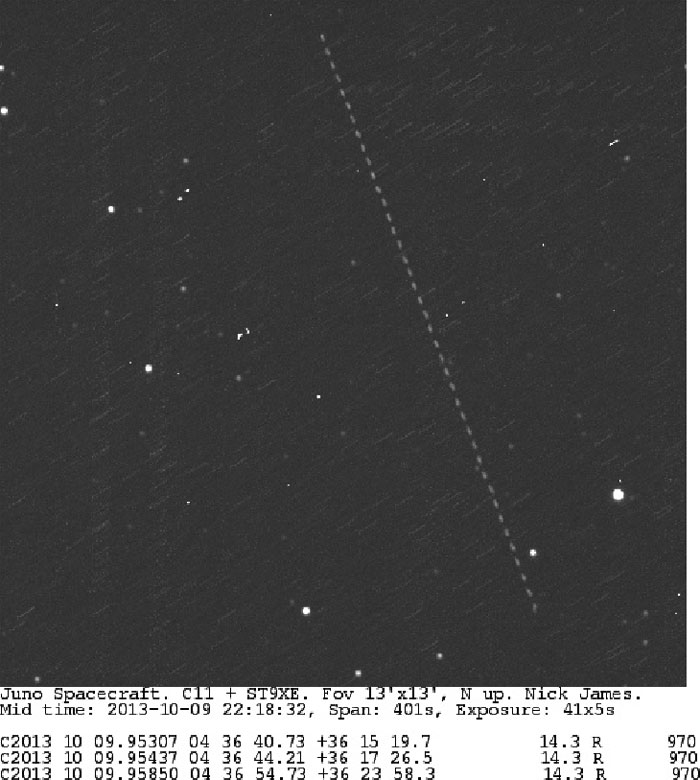
Taken by Nick James on October 9, 2013 @ Juno spacecraft and astrometry obtained with a C11 + ST9XE
.
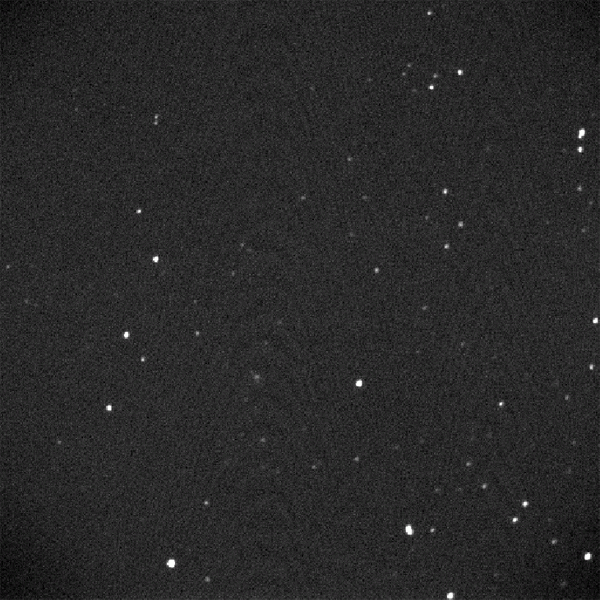
.
Update: 12.10.2013
.
Juno probe in safe mode, but managers optimistic about recovery
NASA's Jupiter-bound Juno spacecraft went into protective "safe mode" just 10 minutes after a low-altitude gravity-assist flyby of Earth Wednesday, but mission managers said Thursday they were back in touch with the spacecraft and optimistic about a full recovery from whatever triggered the upset.
Project Manager Rick Nybakken at the Jet Propulsion Laboratory in Pasadena, Calif., said engineers were downloading stored telemetry from the spacecraft and were developing plans to restore it to normal operation.
"We're starting now to develop a plan to bring the spacecraft back into operational status and we think putting that plan together is going to take a few days," he told CBS News in a telephone interview.
"Obviously, we need to finish downloading and reviewing the current data. The take aways, we're still in safe mode, we're still safe and we're proceeding in a very calm and deliberate manner to take care of this wonderful asset."
The centerpiece of a $1.1 billion mission, Juno was launched atop a United Launch Alliance Atlas 5 rocket from the Cape Canaveral Air Force Station, Fla., on Aug. 5, 2011. Even using the most powerful version of the workhorse rocket, Juno did not have enough energy to fly directly to Jupiter.
Instead, the solar-powered spacecraft was launched on a trajectory that carried it beyond the orbit of Mars and out into the asteroid belt before the sun's gravity finally began pulling the craft back into the inner solar system.
In September 2012, flight controllers carried out precisely timed rocket firings to slightly alter the probe's course, setting up Wednesday's gravity-assist flyby. By flying close to Earth, Juno was able to use the planet's gravity to boost its velocity enough to head out for Jupiter.
Closest approach occurred at 3:21 p.m. EDT (GMT-4) as the spacecraft passed about 350 miles above South Africa, just after entering Earth's shadow for a 19-minute-long eclipse.
Nybakken said Juno's flight computer encountered a problem of some sort 10 minutes after closest approach, triggering automatic safe mode routines designed to put the spacecraft in a stable configuration in the event of unexpected events, programming problems or malfunctions that are beyond its ability to resolve.
In safe mode, the flight computer stops executing stored commands and makes sure the spacecraft is "power positive" with its solar arrays pointed at the sun. The spacecraft then stands by for instructions from Earth.
"We've re-established communications, including full commandability, we verified we were in a safe, stable state, which means sun-pointed and getting power from the arrays as expected," Nybakken said late Thursday. "We are currently going through our diagnostic procedures to analyze the anomaly and just this morning we started downloading and reviewing the on-board engineering and science-slash-imaging data."
Juno was programmed to exercise its instruments during the flyby, capturing views of the Earth-moon system and collecting other data. Nybakken said the imaging sequence started normally and presumably all of the data was recorded on board before the event that triggered the computer's transition to safe mode.
"We're hopeful ... that we'll get all the data up to that point," he said. "But we really won't know until we get it all down and go through it."
Asked if engineers have any ideas about what caused the safe mode transition, Nybakken said "we don't like to speculate. We have some strong suspicions, but I'd rather not put those out" yet. Asked about Juno's overall health, he said the spacecraft appeared to be in good shape.
In the meantime, Juno came through the Earth fly by precisely on course to Jupiter. If all goes well, the spacecrat will brake into a polar orbit around the giant planet on July 4, 2016, kicking off a one-year 33-orbit mission to learn more about Jupiter's atmosphere and evolution.
Quelle: CBS
.
NASA’s Juno Spacecraft Returns 1st Flyby images of Earth while Sailing On to Jupiter
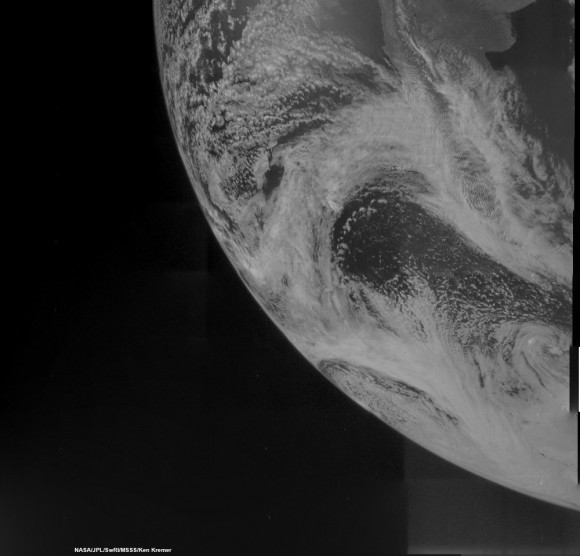
This reconstructed day side image of Earth is one of the 1st snapshots transmitted back home by NASA’s Juno spacecraft during its speed boosting flyby on Oct. 9, 2013. See the original raw image below taken by the probes Junocam imager and methane filter at 12:06:30 PDT and an exposure time of 3.2 milliseconds. Juno was due to be flying over South America and the southern Atlantic Ocean. Credit: NASA/JPL/SwRI/MSSS/Ken Kremer
.
Following the speed boosting slingshot of Earth on Wednesday, Oct. 9, that sent NASA’s Juno orbiter hurtling towards Jupiter, the probe has successfully transmitted back data and the very first flyby images despite unexpectedly going into ‘safe mode’ during the critical maneuver.
“Juno is transmitting telemetry today,” spokesman Guy Webster, of NASA’s Jet Propulsion Lab (JPL), told me in a phone interview late today (Oct. 10), as Juno continues sailing on its 2.8 Billion kilometer (1.7 Billion mile) outbound trek to the Jovian system.
The new images of Earth captured by the Junocam imager serves as tangible proof that Juno is communicating.
“Juno is still in safe mode today (Oct. 10),” Webster told Universe Today.
“Teams at mission control at JPL and Lockheed Martin are actively working to bring Juno out of safe mode. And that could still require a few days,” Webster explained.
Lockheed Martin is the prime contractor for Juno.
The initial raw images of Earth snapped by the craft’s Junocam imager were received by ground stations late today.
See above a day light image mosaic which I reconstructed and realigned based on the original raw image (see below) taken with the camera’s methane filter on Oct. 9 at 12:06:30 PDT (3:06:30 PM EST). Juno was to be flying over South America and the southern Atlantic Ocean.
.
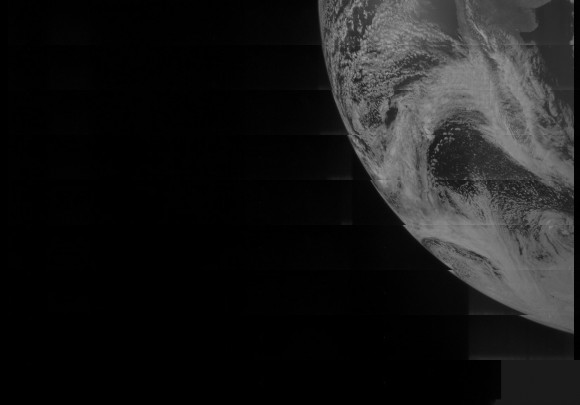
This day side raw image of Earth is one of the 1st snapshots transmitted back home today by NASA’s Juno spacecraft during its speed boosting flyby on Oct. 9, 2013. It was taken by the probes Junocam imager and methane filter at 12:06:30 PDT and an exposure time of 3.2 milliseconds. Juno was due to be flying over South America and the southern Atlantic Ocean. Credit: NASA/JPL/SwRI/MSSS
.
Juno performed a crucial swingby of Earth on Wednesday that accelerated the probe by 16330 MPH to enable it to arrive in orbit around Jupiter on July 4, 2016.
However the gravity assist maneuver did not go entirely as planned.
Shortly after Wednesday’s flyby, Juno Project manager Rick Nybakken, of JPL, told me in a phone interview that Juno had entered safe mode but that the probe was “power positive and we have full command ability.”
“After Juno passed the period of Earth flyby closest approach at 12:21 PM PST [3:21 PM EDT] and we established communications 25 minutes later, we were in safe mode,” Nybakken explained.
The safe mode was triggered while Juno was in an eclipse mode, the only eclipse it will experience during its entire mission.
The Earth flyby did accomplish its objective by placing the $1.1 Billion Juno spacecraft exactly on course for Jupiter as intended.
“We are on our way to Jupiter as planned!”
“None of this affected our trajectory or the gravity assist maneuver – which is what the Earth flyby is,” Nybakken stated.
Juno’s closest approach was over South Africa at about 561 kilometers (349 miles).
During the flyby, the science team also planned to observe Earth using most of Juno’s nine science instruments since the slingshot also serves as a key test of the spacecraft systems and the flight operations teams.
Juno also was to capture an unprecedented new movie of the Earth/Moon system.
Many more images were snapped and should be transmitted in coming days that eventually will show a beautiful view of the Earth and Moon from space.
“During the earth flyby we have most of our instruments on and will obtain a unique movie of the Earth Moon system on our approach, Juno principal investigator Scott Bolton told me. Bolton is from the Southwest Research Institute (SwRI), San Antonio, Texas.
“We will also calibrate instuments and measure earth’s magnetosphere, obtain closeup images of the Earth and the Moon in UV [ultraviolet] and IR [infrared],” Bolton explained to Universe Today.
Juno is approaching the Earth from deep space, from the sunlit side.
“Juno will take never-before-seen images of the Earth-moon system, giving us a chance to see what we look like from Mars or Jupiter’” says Bolton.
Here is a description of Junocam from the developer – Malin Space Science Systems
“Like previous MSSS cameras (e.g., Mars Reconnaissance Orbiter’s Mars Color Imager) Junocam is a “pushframe” imager. The detector has multiple filter strips, each with a different bandpass, bonded directly to its photoactive surface. Each strip extends the entire width of the detector, but only a fraction of its height; Junocam’s filter strips are 1600 pixels wide and about 155 rows high. The filter strips are scanned across the target by spacecraft rotation. At the nominal spin rate of 2 RPM, frames are acquired about every 400 milliseconds. Junocam has four filters: three visible (red/green/blue) and a narrowband “methane” filter centered at about 890 nm.”
During a one year long science mission – entailing 33 orbits lasting 11 days each – the probe will plunge to within about 3000 miles of the turbulent cloud tops and collect unprecedented new data that will unveil the hidden inner secrets of Jupiter’s origin and evolution.
.
.
Update: 25.07.2014
.
Juno-Sonde auf JUpiter-Kurs
.
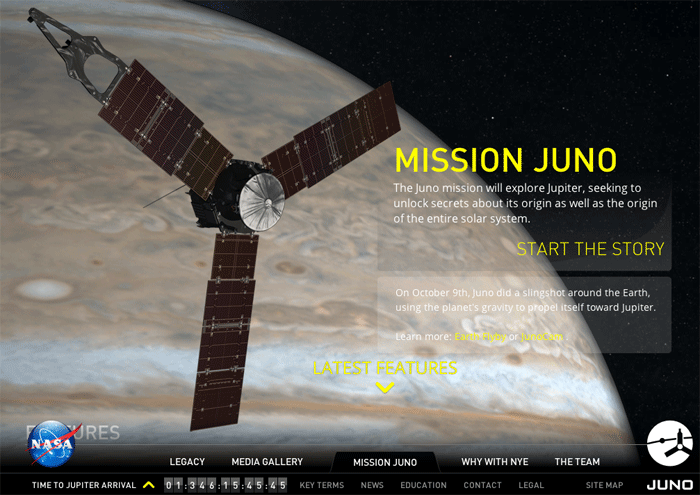
.
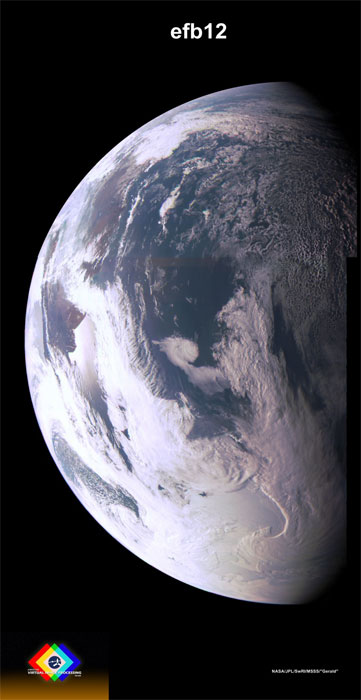
Rückblick: JUNO-Sonde Erde-Blick bei FlyBy
.
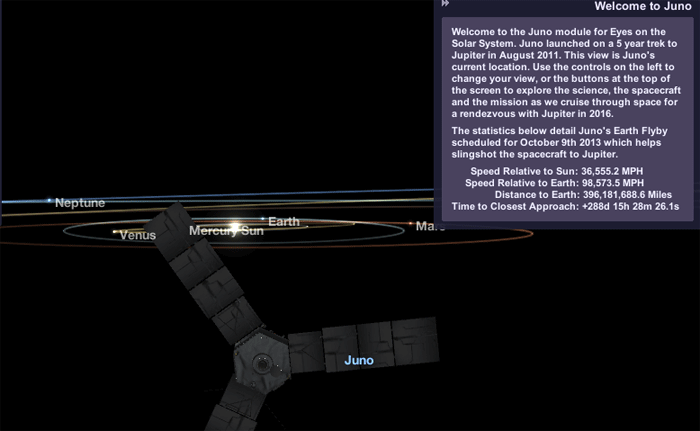

Quelle: NASA
.
Update: 15.12.2014
.
NASA's Juno Gives Starship-Like View of Earth Flyby
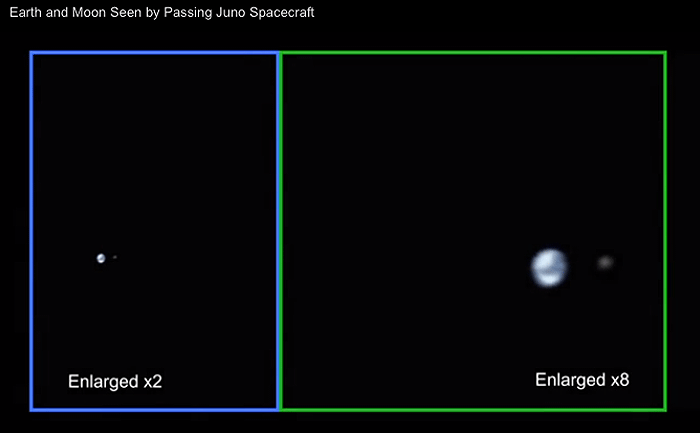
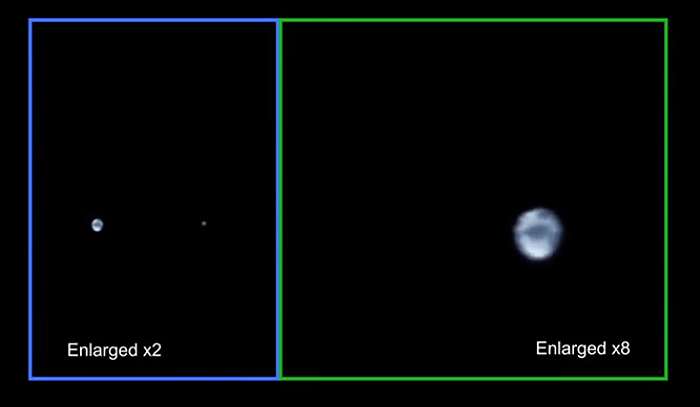
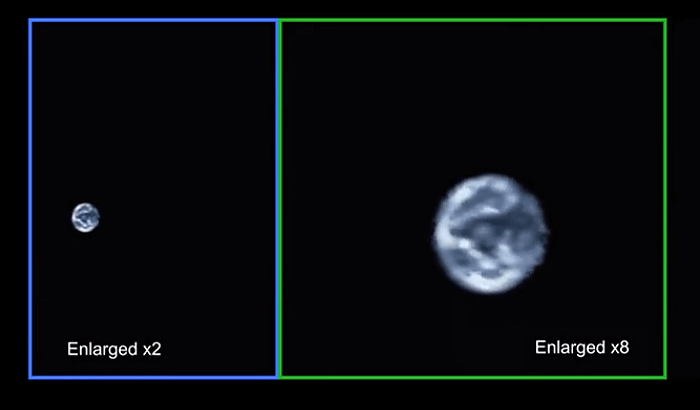
This cosmic pirouette of Earth and our moon was captured by the Juno spacecraft as it flew by Earth on Oct. 9, 2013.
.
